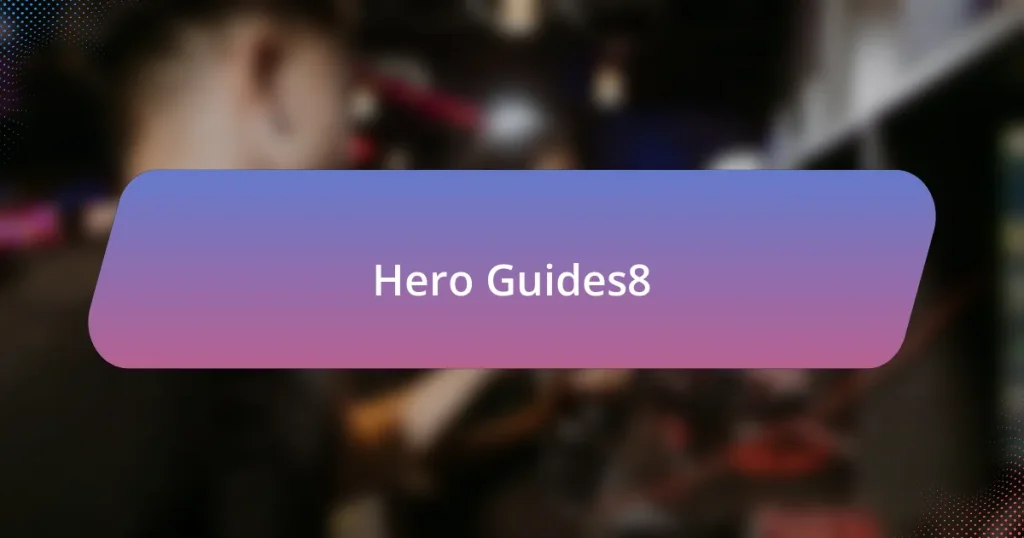Building a team around a core hero involves assembling characters that enhance the hero’s strengths and mitigate weaknesses, creating effective synergies for achieving common objectives. A core hero is typically the primary damage dealer, and their effectiveness is amplified by team members with complementary roles, such as support and tank characters. Key characteristics for suitable heroes include adaptability, strong communication skills, and a collaborative mindset, all of which contribute to team dynamics and synergy. The article explores strategies for selecting team members, assessing potential counters, and maintaining synergy, emphasizing the importance of clear communication and defined roles for optimal team performance.

What does it mean to build a team around a core hero?
Building a team around a core hero means assembling a group of characters that complement and enhance the strengths of that central hero while mitigating their weaknesses. This approach focuses on creating synergies, where each team member’s abilities work together effectively to achieve common objectives, such as winning battles or completing missions. For example, in team-based games, a tank hero can absorb damage while a support hero heals and buffs the core hero, maximizing their effectiveness in combat. This strategy is validated by game design principles that emphasize the importance of teamwork and role specialization, which enhance overall performance and success rates in competitive environments.
How do you define a core hero in team composition?
A core hero in team composition is defined as a central character that serves as the primary damage dealer or main source of impact in a game. This hero typically possesses abilities that scale well with resources, allowing them to become more powerful as the game progresses. Core heroes are essential for securing objectives and winning fights, as they often dictate the pace and strategy of the game. Their effectiveness is supported by the team through synergies, such as providing crowd control or healing, which enhances the core hero’s performance and survivability in engagements.
What characteristics make a hero suitable for a team?
A hero suitable for a team possesses characteristics such as adaptability, strong communication skills, and a collaborative mindset. Adaptability allows the hero to adjust strategies based on team dynamics and opponents, enhancing overall effectiveness. Strong communication skills facilitate clear information sharing, which is crucial for coordinating actions and strategies within the team. A collaborative mindset fosters teamwork, encouraging the hero to support and uplift teammates, ultimately leading to a more cohesive unit. These traits are essential for maximizing team performance and achieving collective goals.
How does the role of a core hero influence team dynamics?
The role of a core hero significantly influences team dynamics by establishing a focal point for strategy and collaboration. Core heroes often serve as the primary damage dealer or playmaker, which encourages teammates to adapt their roles to support and enhance the hero’s effectiveness. This dynamic fosters a sense of unity and purpose within the team, as players coordinate their abilities and resources to maximize the core hero’s impact. For instance, in games like Dota 2, the presence of a strong core hero can dictate the team’s positioning and engagement strategies, leading to a more cohesive and synergistic gameplay experience.
Why is team synergy important when building around a core hero?
Team synergy is crucial when building around a core hero because it enhances the overall effectiveness and performance of the team. When team members complement each other’s strengths and weaknesses, they create a cohesive unit that can execute strategies more efficiently. For instance, a core hero may excel in dealing damage but lack crowd control; pairing them with heroes that provide crowd control can maximize their damage output and survivability. This strategic alignment leads to higher win rates, as evidenced by data from competitive gaming statistics, which show that teams with strong synergy often outperform those without it.
What are the key elements of synergy in a team setting?
The key elements of synergy in a team setting include effective communication, complementary skills, shared goals, mutual trust, and collaborative problem-solving. Effective communication ensures that team members can share ideas and feedback openly, which enhances understanding and coordination. Complementary skills allow team members to leverage each other’s strengths, creating a more versatile and capable team. Shared goals align the team’s efforts towards a common objective, fostering unity and motivation. Mutual trust builds a safe environment where members feel valued and are more willing to take risks. Collaborative problem-solving encourages innovative solutions by integrating diverse perspectives, leading to better outcomes. These elements collectively enhance team performance and productivity.
How can synergy enhance the effectiveness of a core hero?
Synergy enhances the effectiveness of a core hero by amplifying their strengths and compensating for their weaknesses through coordinated teamwork. When team members possess complementary abilities, they can create powerful combinations that maximize damage output, control the battlefield, or provide essential support. For instance, a core hero with high damage potential can benefit from a support character that provides healing or crowd control, allowing the core hero to remain active in fights longer and deal more damage. This collaborative dynamic not only increases the overall performance of the core hero but also improves team cohesion and strategy, leading to higher success rates in engagements.
What are common strategies for selecting team members around a core hero?
Common strategies for selecting team members around a core hero include identifying complementary roles, ensuring balance in skills, and considering synergy effects. Complementary roles involve selecting team members whose abilities enhance the core hero’s strengths or mitigate weaknesses, such as pairing a damage dealer with a support character. Balancing skills ensures that the team has a mix of offensive and defensive capabilities, which is crucial for adaptability in various scenarios. Synergy effects refer to choosing characters whose abilities work well together, creating powerful combinations that can dominate opponents. For example, a core hero with crowd control abilities can benefit from teammates who can capitalize on immobilized enemies, leading to higher overall effectiveness in team engagements.
How do you identify complementary skills in potential team members?
To identify complementary skills in potential team members, assess their individual strengths and weaknesses in relation to the team’s objectives. This involves evaluating candidates’ past experiences, technical abilities, and interpersonal skills through structured interviews and assessments. For instance, a study by the Harvard Business Review indicates that teams with diverse skill sets outperform homogeneous teams by 35% in problem-solving tasks. By analyzing how a candidate’s skills fill gaps in the existing team composition, you can ensure a balanced and effective team dynamic.
What roles should be prioritized when forming a team around a core hero?
When forming a team around a core hero, the roles that should be prioritized are support, tank, and damage dealer. Support roles are essential for providing healing and utility, which enhances the core hero’s survivability and effectiveness in battles. Tanks absorb damage and create space, allowing the core hero to operate more freely. Damage dealers complement the core hero’s abilities by maximizing damage output, ensuring that the team can secure kills and objectives efficiently. Prioritizing these roles creates a balanced team composition that leverages the strengths of the core hero while addressing potential weaknesses.
How do you assess potential counters to a core hero?
To assess potential counters to a core hero, analyze the hero’s strengths and weaknesses in relation to the opposing heroes’ abilities. Identifying heroes that exploit the core hero’s vulnerabilities, such as those with crowd control or burst damage, is crucial. For example, if a core hero relies heavily on mobility, heroes with stuns or silences can effectively counter them. Additionally, reviewing match statistics and professional gameplay can provide insights into effective counters, as certain heroes consistently perform well against specific core heroes in competitive settings.
What factors should be considered when identifying counters?
When identifying counters, one should consider the strengths and weaknesses of both the core hero and the opposing characters. The core hero’s abilities, role in the team, and synergy with other team members are crucial factors. Additionally, understanding the enemy’s composition, including their damage types, crowd control capabilities, and overall strategy, is essential for effective countering. For instance, if the core hero is vulnerable to magic damage, selecting characters with magic resistance or abilities that can negate or mitigate that damage will enhance the team’s effectiveness against specific threats.
How can understanding counters improve team strategy?
Understanding counters enhances team strategy by enabling teams to effectively counter opponents’ strengths and exploit their weaknesses. This strategic awareness allows teams to select heroes or roles that can neutralize threats posed by enemy heroes, thereby increasing their chances of winning engagements. For instance, in competitive gaming, if a team recognizes that the opposing team relies heavily on a specific hero, they can choose heroes that are known to counter that hero, leading to a tactical advantage. This approach is supported by data from gameplay analytics, which show that teams that effectively utilize counters have a higher win rate, as they can dictate the flow of the game and force opponents into unfavorable matchups.
What are the best practices for maintaining team synergy?
The best practices for maintaining team synergy include clear communication, defined roles, and regular feedback. Clear communication ensures that all team members understand objectives and expectations, which fosters collaboration. Defined roles help each member know their responsibilities, reducing overlap and confusion. Regular feedback allows for continuous improvement and alignment, ensuring that the team adapts to challenges effectively. Research indicates that teams with strong communication and defined roles are 25% more productive than those without these practices, highlighting their importance in maintaining synergy.
How can communication be optimized within the team?
Effective communication can be optimized within the team by implementing structured communication channels and regular feedback loops. Establishing clear protocols for information sharing, such as using project management tools and scheduled meetings, ensures that all team members are aligned and informed. Research indicates that teams with defined communication strategies experience a 25% increase in productivity, as they minimize misunderstandings and enhance collaboration. Regular feedback sessions further reinforce this by allowing team members to address issues promptly and adjust their approaches, fostering a culture of continuous improvement.
What methods can be used to evaluate team performance regularly?
Regular evaluation of team performance can be achieved through methods such as performance metrics, peer reviews, and regular feedback sessions. Performance metrics involve quantifiable data, such as project completion rates and quality of work, which provide objective insights into team effectiveness. Peer reviews allow team members to assess each other’s contributions, fostering accountability and collaboration. Regular feedback sessions, whether through one-on-one meetings or team discussions, facilitate open communication about strengths and areas for improvement, ensuring continuous development. These methods collectively enhance team dynamics and performance by providing structured and actionable insights.
How can you adapt your team strategy based on the core hero’s performance?
To adapt your team strategy based on the core hero’s performance, first assess the hero’s strengths and weaknesses during gameplay. If the core hero excels in damage output but struggles with survivability, the team should focus on providing protective support and crowd control to enhance their effectiveness. Conversely, if the hero is underperforming, consider adjusting the team composition to include heroes that can complement their abilities, such as those that can initiate fights or provide healing. This approach is validated by the principle of synergy in team dynamics, where effective combinations can significantly improve overall performance. For instance, in competitive gaming, teams often analyze hero statistics and win rates to inform strategic adjustments, demonstrating the importance of data-driven decision-making in optimizing team strategies.
What indicators suggest a need for team adjustments?
Indicators that suggest a need for team adjustments include a decline in team performance metrics, such as win rates or objective control, and noticeable communication breakdowns among team members. When a team consistently underperforms, it often reflects a misalignment in roles or strategies, necessitating a reassessment of team composition. Additionally, if team members report feeling uncoordinated or if there are frequent conflicts, these are clear signs that adjustments are required to enhance synergy and effectiveness.
How can feedback loops be established for continuous improvement?
Feedback loops can be established for continuous improvement by implementing regular assessments and open communication channels within a team. These assessments can include performance reviews, surveys, and feedback sessions that allow team members to share insights and suggestions. Research indicates that organizations that utilize structured feedback mechanisms, such as the 360-degree feedback model, see a 14.9% improvement in employee performance (Source: “The Impact of 360-Degree Feedback on Employee Performance,” by Atwater and Waldman). This structured approach ensures that feedback is not only collected but also acted upon, fostering a culture of continuous improvement.
What practical tips can enhance team building around a core hero?
To enhance team building around a core hero, focus on selecting complementary heroes that maximize the core hero’s strengths. For instance, if the core hero excels in damage output, pairing them with heroes that provide crowd control or healing can create a balanced team dynamic. Additionally, establish clear communication among team members to coordinate strategies effectively, ensuring that everyone understands their roles in relation to the core hero. Regular practice sessions can also improve synergy, allowing the team to refine their tactics and adapt to various scenarios. These strategies are supported by game design principles that emphasize the importance of synergy and teamwork in competitive environments.













